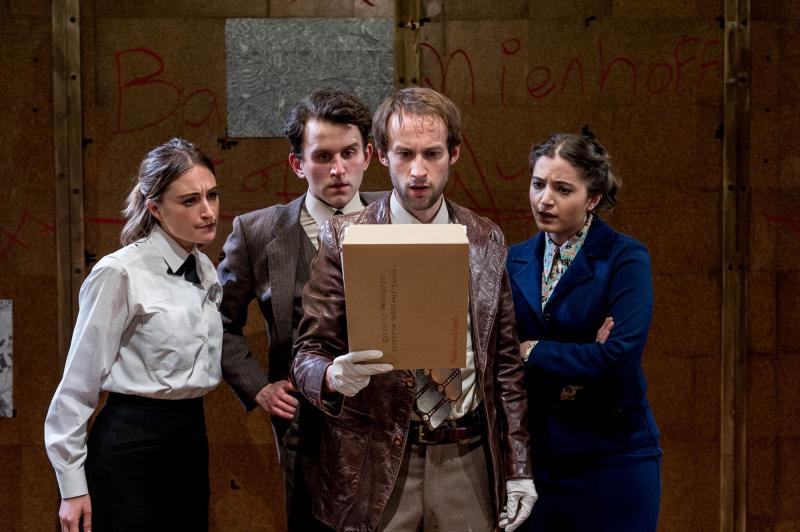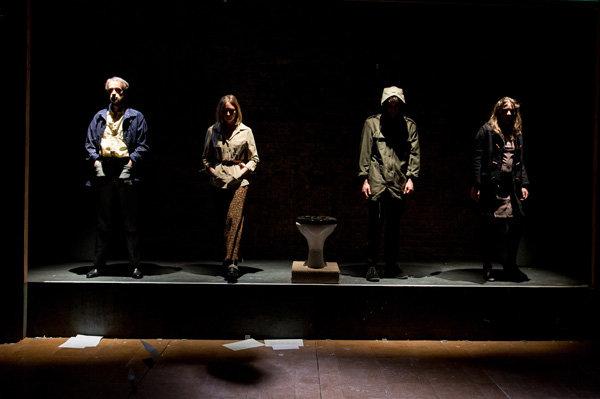The Angry Brigade, Bush Theatre | reviews, news & interviews
The Angry Brigade, Bush Theatre
The Angry Brigade, Bush Theatre
Paines Plough's documentary about the 1970s urban terror group is thrillingly theatrical

Today, terrorism means killing as many innocent people as possible. Fear is created by completely random attacks, so that no one feels safe. But there was a time, in the past, when political anarchists would focus their attacks on selected targets and avoid civilian casualties. For a year, begining in August 1970, the Angry Brigade brought armed struggle to Britain, setting off some 25 bombs, mainly aimed at the property of the rich and powerful (although one person was slightly injured).
At the end of the 1960s, British society was riven by conflict. Waves of industrial strikes were countered by a Tory government determined to pass laws that penalised the trade unions. Class war was in the air. In this heady atmosphere, many young people were radicalised, moving from student activism to outright revolt. A small handful of them formed the Angry Brigade and embarked on a mission to fight back against the Tories – by any means necessary. Their actions included using small home-made bombs against targets such as banks, boutiques, embassies, the Miss World contest, judges and several Tory MPs. These were announced by communiqués, written in the language of the left counterculture and of the French situationists, and were incomprehensible to the police.
Traditional-minded detectives are puzzled by these mysterious actions
Part One of James Graham’s documentary about the Angry Brigade is called The Branch and opens in a basement in Scotland Yard where traditional-minded detectives are puzzled by these mysterious actions. Detective Robert Smith struggles to get his head around a world of young people he doesn’t remotely understand, so the piece begins by exploring and explaining a world we have lost: a place of radical hippies, enraged students, alternative bookshops and rock music. It puts the Angries into their social and political context.
Led by Smith, a team is formed – DC Morris, WPC Henderson and WPC Parker – and they investigate the hippie underground. The beguiling thing about Graham’s inventive account is that he imagines that these staid young police officers are changed – their minds blown – by the ideas they encounter in their research. James Grieve’s imaginative production, with its fab soundtrack, vibrating projections and air of anarchy, offers an attractive and informative piece of info-drama.
 Then, in Part Two, called The Brigade, we are welcomed inside the home of these activists: 359 Amhurst Road. We watch how they take down doors and knock down walls, liberating the architecture as well as their minds. Using songs from musicals, from television adverts, and from rock music (a great riff from Hawkwind), this section explores the relationships between John, Jim, Anna and Hilary, and shows how their privileged backgrounds were a factor in their radicalisation. This part is full of lefty ideas, of revolutionary rhetoric and of psychological insight.
Then, in Part Two, called The Brigade, we are welcomed inside the home of these activists: 359 Amhurst Road. We watch how they take down doors and knock down walls, liberating the architecture as well as their minds. Using songs from musicals, from television adverts, and from rock music (a great riff from Hawkwind), this section explores the relationships between John, Jim, Anna and Hilary, and shows how their privileged backgrounds were a factor in their radicalisation. This part is full of lefty ideas, of revolutionary rhetoric and of psychological insight.
Grieve’s production throbs with exciting theatrical effects, and Graham’s text is politically insightful – he has clearly drunk from the deep well of 1968er ideas so the piece is brilliantly imaginative as well as informative. It is a documentary with no trace of dusty research; like a vinyl rock record, it has the power to blow your mind. Appealing performances from a cast of four (pictured above) – Mark Arends (Smith/John), Pearl Chanda (Henderson/Anna), Harry Melling (Morris/Jim) and Lizzy Watts (Parker/Hilary), who also play other roles – mean that The Angry Brigade is a thrilling and highly enjoyable evening. Right on!
rating
Share this article
The future of Arts Journalism
You can stop theartsdesk.com closing!
We urgently need financing to survive. Our fundraising drive has thus far raised £49,000 but we need to reach £100,000 or we will be forced to close. Please contribute here: https://gofund.me/c3f6033d
And if you can forward this information to anyone who might assist, we’d be grateful.

Subscribe to theartsdesk.com
Thank you for continuing to read our work on theartsdesk.com. For unlimited access to every article in its entirety, including our archive of more than 15,000 pieces, we're asking for £5 per month or £40 per year. We feel it's a very good deal, and hope you do too.
To take a subscription now simply click here.
And if you're looking for that extra gift for a friend or family member, why not treat them to a theartsdesk.com gift subscription?
more Theatre
 The Assembled Parties, Hampstead review - a rarity, a well-made play delivered straight
Witty but poignant tribute to the strength of family ties as all around disintegrates
The Assembled Parties, Hampstead review - a rarity, a well-made play delivered straight
Witty but poignant tribute to the strength of family ties as all around disintegrates
 Mary Page Marlowe, Old Vic review - a starry portrait of a splintered life
Tracy Letts's Off Broadway play makes a shimmeringly powerful London debut
Mary Page Marlowe, Old Vic review - a starry portrait of a splintered life
Tracy Letts's Off Broadway play makes a shimmeringly powerful London debut
 Little Brother, Soho Theatre review - light, bright but emotionally true
This Verity Bargate Award-winning dramedy is entertaining as well as thought provoking
Little Brother, Soho Theatre review - light, bright but emotionally true
This Verity Bargate Award-winning dramedy is entertaining as well as thought provoking
 The Unbelievers, Royal Court Theatre - grimly compelling, powerfully performed
Nick Payne's new play is amongst his best
The Unbelievers, Royal Court Theatre - grimly compelling, powerfully performed
Nick Payne's new play is amongst his best
 The Maids, Donmar Warehouse review - vibrant cast lost in a spectacular-looking fever dream
Kip Williams revises Genet, with little gained in the update except eye-popping visuals
The Maids, Donmar Warehouse review - vibrant cast lost in a spectacular-looking fever dream
Kip Williams revises Genet, with little gained in the update except eye-popping visuals
 Ragdoll, Jermyn Street Theatre review - compelling and emotionally truthful
Katherine Moar returns with a Patty Hearst-inspired follow up to her debut hit 'Farm Hall'
Ragdoll, Jermyn Street Theatre review - compelling and emotionally truthful
Katherine Moar returns with a Patty Hearst-inspired follow up to her debut hit 'Farm Hall'
 Troilus and Cressida, Globe Theatre review - a 'problem play' with added problems
Raucous and carnivalesque, but also ugly and incomprehensible
Troilus and Cressida, Globe Theatre review - a 'problem play' with added problems
Raucous and carnivalesque, but also ugly and incomprehensible
 Clarkston, Trafalgar Theatre review - two lads on a road to nowhere
Netflix star, Joe Locke, is the selling point of a production that needs one
Clarkston, Trafalgar Theatre review - two lads on a road to nowhere
Netflix star, Joe Locke, is the selling point of a production that needs one
 Ghost Stories, Peacock Theatre review - spirited staging but short on scares
Impressive spectacle saves an ageing show in an unsuitable venue
Ghost Stories, Peacock Theatre review - spirited staging but short on scares
Impressive spectacle saves an ageing show in an unsuitable venue
 Hamlet, National Theatre review - turning tragedy to comedy is no joke
Hiran Abeyeskera’s childlike prince falls flat in a mixed production
Hamlet, National Theatre review - turning tragedy to comedy is no joke
Hiran Abeyeskera’s childlike prince falls flat in a mixed production
 Rohtko, Barbican review - postmodern meditation on fake and authentic art is less than the sum of its parts
Łukasz Twarkowski's production dazzles without illuminating
Rohtko, Barbican review - postmodern meditation on fake and authentic art is less than the sum of its parts
Łukasz Twarkowski's production dazzles without illuminating
 Lee, Park Theatre review - Lee Krasner looks back on her life as an artist
Informative and interesting, the play's format limits its potential
Lee, Park Theatre review - Lee Krasner looks back on her life as an artist
Informative and interesting, the play's format limits its potential

Add comment